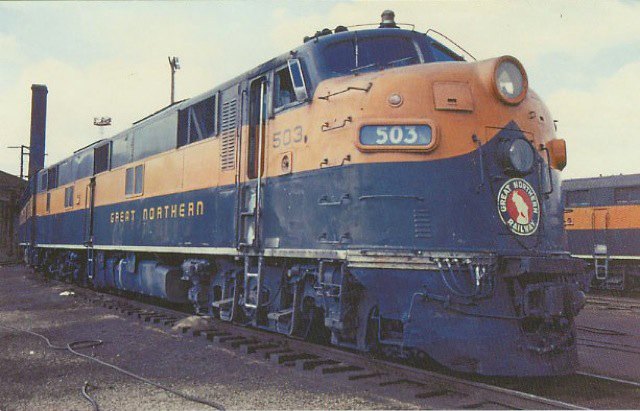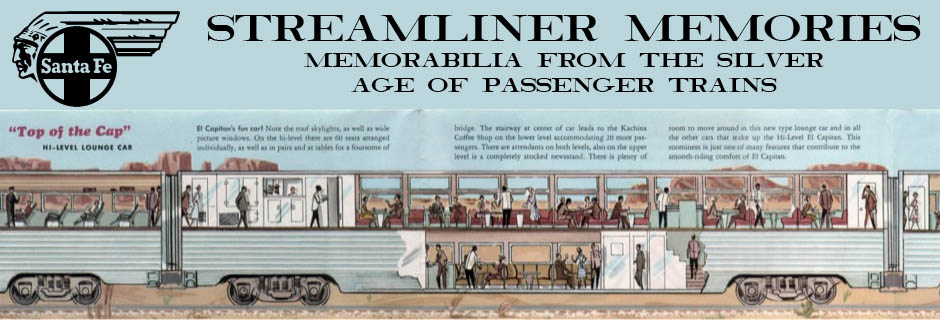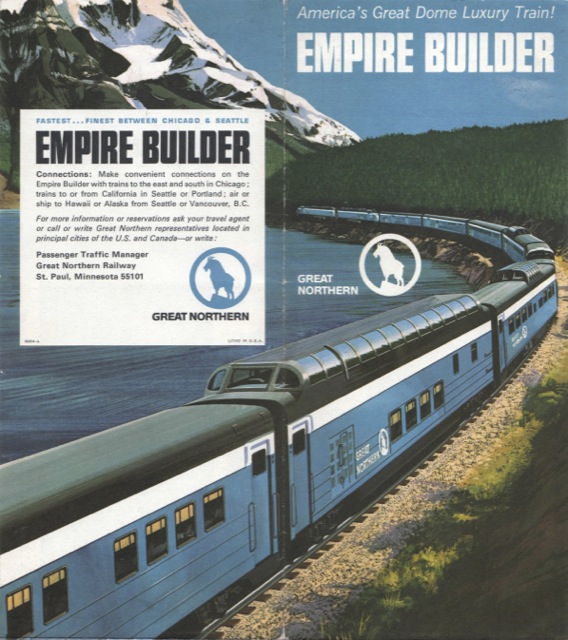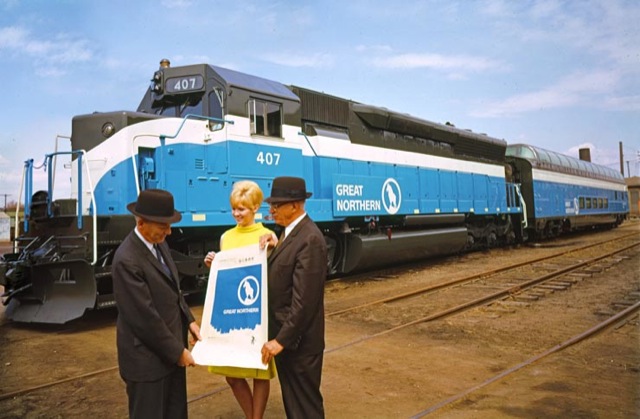Even as the Seattle World’s Fair started up, the Great Northern was simplifying the paint scheme of its Diesel locomotives. Since the railroad had first purchased FT Diesels in 1941, it painted them Pullman green with two large orange stripes, three yellow pin stripes, and a white reflective stripe. The 1947 streamlined Empire Builder color scheme was actually based on what was originally the colors of a freight locomotive.

The simplified scheme applied to an E-7. This is a far cry from the beautiful scheme with forward-facing goats and “Great Northern” in script on the nose in which these units were first delivered.
In May, 1962, however, the Great Northern began painting its Diesels in a simplified scheme that was Pullman green with just one orange stripe and no pinstripes. At the time, the GN estimated that this change saved $27.50 in materials (more than $200 in today’s money) and 16 hours of labor per locomotive. Fortunately, this simplified scheme wasn’t applied to the passenger cars, and the railway must have recognized that it made the locomotives uglier as that scheme is not pictured in any advertisement or brochure that I can find.
In 1967, with great fanfare, the Great Northern announced that it was simplifying its entire fleet of locomotives and passenger cars with a new “Big Sky Blue” color scheme. Railfans may debate endlessly whether Big Sky Blue looked better or worse than orange-and-green, but the bottom line was that Big Sky Blue was easier to paint. The undercarriage and roof were grey, while the sides of the cars and locomotives were bright blue with one white stripe and no pinstripes.
This brochure features the Empire Builder in Big-Sky Blue. Click image to download a 4.7-MB PDF of the brochure.
Big-Sky Blue was certainly a distinctive shade of blue, quite different from the blues on the Baltimore & Ohio, Missouri Pacific, and Wabash streamliners. However, the paint was poorly selected as it tended to fade after just two years. The first car to be painted Big-Sky Blue was the full-length dome “Prairie View,” which, ironically, was recently restored into its original orange-and-green by current owner Iowa Pacific.
With the new colors, the Empire Builder lost its distinction as one of the last trains with its own name (and in its own font) on the letter boards. Instead, an updated goat appeared with the words “Great” above “Northern” in white on the locomotives and cars below the normal window line. The font was hardly unique, being some sort of standard gothic font with only the “G” of “Great” tweaked to have a distinctive appearance. (In other contexts, such as the names of passenger cars, the “G”s were from the standard font.)
According to GN executive Robert Downing, who later became CEO of Burlington Northern, the Big-Sky Blue scheme was not, as some believed, planned as a post-merger scheme. Instead, both it and the revised goat was suggested to the railroad by Lippincott and Margulies, a firm that (under the name Lippincott) still helps other companies with “brand strategy and design.”
GN executives proudly stand in front of a new SDP-45 and dome “Prairie View” in Big-Sky Blue colors holding a broadsheet of an ad that appeared in newspapers throughout the railway’s service area announcing the new paint scheme. Click image for a slightly larger view of this GN/BNSF photo.
At the same time as it adopted Big-Sky Blue, Great Northern purchased SDP-45 locomotives to replace the F units that had pulled the Empire Builder and Western Star since 1951. Each SDP-45 had more than twice the horsepower of the most powerful Fs, so two SDP-45s replaced four Fs. But, far from being streamlined, the locomotives were boxy in shape and resembled locomotives that had been predominantly used for freight trains.
The Santa Fe, at least, recognized this and asked General Motors to put a cowl around the locomotives so they would not have external walkways around the sides. The result was the FP-45, but even then the result wasn’t truly streamlined. Combined with the permanent loss of the Empire Builder‘s observation cars after the 1962 summer season, the Great Northern could no longer call its premiere train a “streamliner.”
The railroad never got around to painting all of its locomotives and passenger cars before the 1970 Burlington Northern merger, but it did more than just repaint those that it did. It also completely refurbished the interiors with new paint and upholstery and other updates. By this time, many of the streamlined cars in its fleet were twenty years old and in need of replacement, but considering declining passenger ridership, updates were all that were likely to happen–and more than passengers on many other railroads would see.


